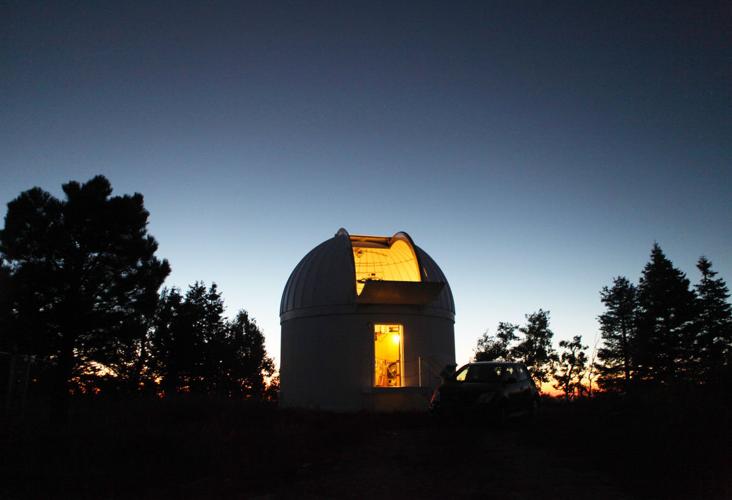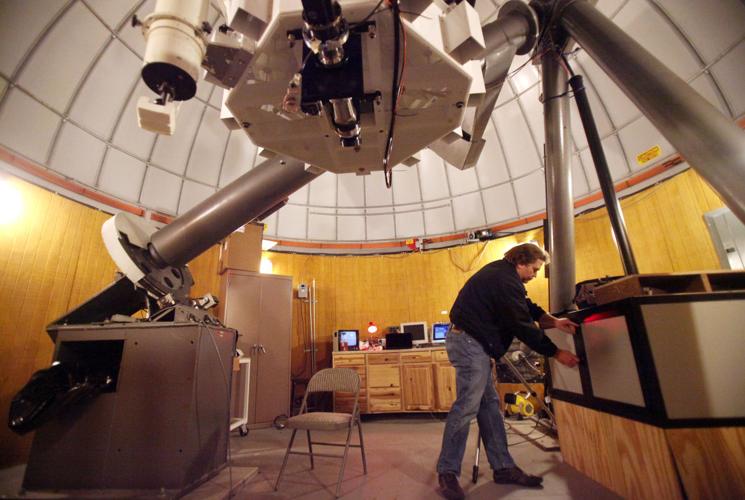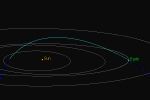The Catalina Sky Survey atop Mount Lemmon has given astronomers another target for study — an apparent piece of space junk expected to burn up over the Indian Ocean next month.
It will arrive on Friday the 13th of November. That ominous date, along with news of a large asteroid that will pass beyond the moon’s orbit on Halloween, has triggered some scary headlines on the Internet.
You have nothing to fear, astronomers say.
The Catalina Sky Survey, a NASA-funded hunt for near-Earth objects run by the University of Arizona Lunar and Planetary Laboratory, detected the incoming piece of space shrapnel most recently on Oct. 3.
It had seen it two times in the past, allowing astronomers to calculate its orbit and predict the time and place for its meeting with the Earth’s atmosphere — midday on Friday, Nov. 13, over the Indian Ocean off the southern coast of Sri Lanka.
The object is small and not very dense, leading to the current hypothesis that it is the shell of a booster rocket, said Eric Christensen, principal investigator for Catalina Sky Survey.
Christensen said his group’s professional interest was satisfied when they figured out at second sighting that it was not a hazardous asteroid. “It’s kind of a novel distinction for us, but not part of our mission,” he said.
That doesn’t mean it’s not interesting, Christensen said. “It’s a nice test run. It allows us to exercise our systems for calculating the orbit and identifying it,” he said.
A host of observatories are now following the path of the object.
Nicholas Moskovitz of Lowell Observatory performs follow-up tracking on about 10 percent of near-Earth objects (NEOs) discovered by NASA with the Mission Accessible Near-Earth Objects Survey (MANOS).
He is working to define the orbit and characterize the makeup of this latest one. On Monday, he used Lowell Observatory’s the 4.3-meter Discovery Channel Telescope to make a series of observations as the object passed close to Earth.
Those observations confirmed that it has “extremely low mass.” That means it is definitely not an asteroid and gives credence to the notion that it is the hollow shell of a rocket part.
Moskovitz is also working with colleagues at the Jet Propulsion Laboratory and elsewhere to refine the orbit and pinpoint its entry.
The object is “not dangerous at all,” said Moskovitz. Hollow and about 2 meters long, it will almost certainly burn up in the Earth’s atmosphere, he said. If pieces of it somehow survived, they would fall harmlessly into the ocean.
It happens all the time, he said. “We get artificial things coming through with regularity. This is a unique case, because we know it’s coming.”
NASA and the Defense Department track more than 500,000 Earth-orbiting space objects the size of a marble or larger, according to NASA’s website.
Astronomers hope to image the incoming object as it collides with the Earth’s atmosphere. Moskovitz said his colleague, Peter Jenniskens of the SETI Institute in California, has chartered a plane to hunt down and attempt to image the object and gather spectrographic information.
“This is a rare opportunity to watch it happen in real time — an exciting opportunity,” said Moskowitz.
The space debris, catalogued as WT1190F, is not the only space visitor being watched this week.
A 2,000-foot-wide asteroid dubbed “the great pumpkin” will pass just outside the orbit of Earth’s moon on Saturday — Halloween.
Asteroid 2015 TB145 was discovered on Oct. 10 by the University of Hawaii’s Pan-STARRS-1 Telescope. Despite the particularly scary time of year, NASA is not worried. It will get no closer than 300,000 miles from the Earth, its website says.
That’s close enough to be observed by skilled amateur astronomers and close enough for NASA to create a high-resolution image of the asteroid, using giant radio telescopes on Earth.







